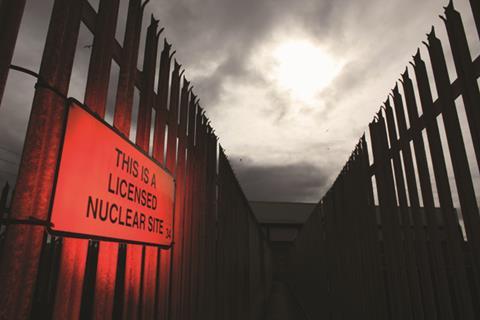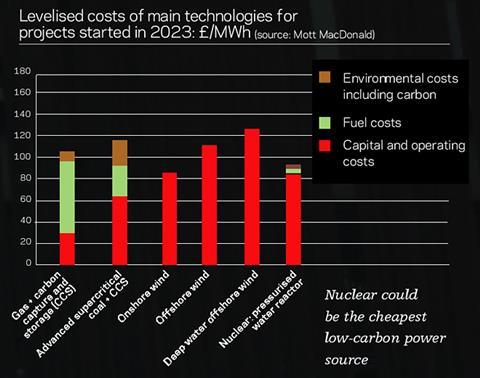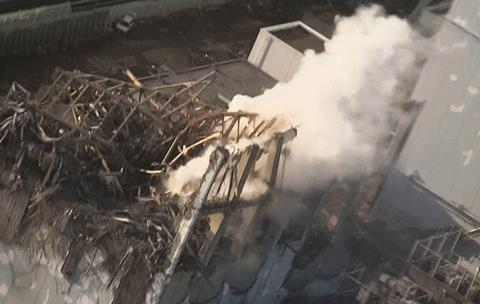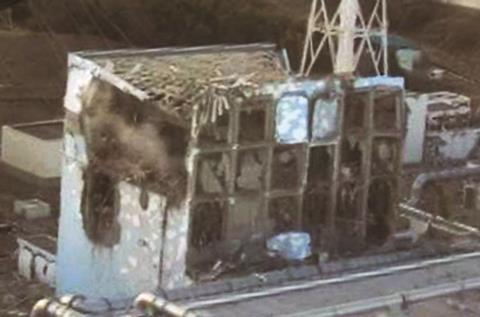In the weeks following fukushima, the UK nuclear industry is already under review. what does this mean for the future of £50bn new build plan?

At 2.46pm Japan Standard Time, two weeks ago today, the largest earthquake ever recorded in Japan struck the Fukushima Daiichi nuclear power plant. Built to withstand earthquakes, the structures survived the shaking intact and automatically shut down safely as power failed. However, as the world now knows, about one hour later a 7m tsunami overwhelmed the sea wall protecting the complex, knocking out the backup generators that had taken over the task of powering the pumps that cooled the six reactors. There was no third failsafe. The shockwaves from this second event will affect the nuclear industry worldwide.
Already both China and Germany have announced temporary suspensions of their nuclear programmes while reviews are carried out. In the UK Chris Huhne, the energy secretary, has commissioned a report into the lessons to be learned from Fukushima, but policy - for the moment - remains the same. That policy is to see the generation of an additional 16GW of electricity by 2025, which in theory means the construction of 10 new reactors at a cost of anything up to £50bn. Starting with EDF’s £10bn plan for two reactors at Hinkley Point in Somerset, the programme has the potential to save the construction industry’s bacon in an era of very limited public spending. The question is whether the tragedy in Japan will change everything.
So what has happened in the UK so far? Last week Huhne commissioned Dr Mike Weightman, the chief nuclear inspector, to report by September on the implications of the accident for the UK, with interim findings in May. The industry is signed up to this approach, designed as it is to reassure the public that there is no complacency on the part of the government. Hence Vincent de Rivas, EDF Energy’s managing director, spent the weekend talking publicly of EDF’s “undimmed” desire to build new plants. But in reality the review has a number of immediate implications. Firstly the energy and climate change department has admitted that there can be no confirmation of the national planning policy for nuclear, the document which names the sites for new power stations, until at least the interim findings of Weightman’s review. More worryingly, sources close to the department suggest the conclusion of the Generic Design Assessment (GDA) process being undertaken by the Health and Safety Executive, to green light the proposed designs, will also be set back. This was due provisionally to complete at the end of June. Peter Atherton, utilities analyst at Citibank, says: “People accept there is almost certain to be a delay in the new build process, of anything from three months, to six months, to two years.”

However, much more important than the delays will be the conclusions of the review. The first impact will be technical: does what happened in Japan change how UK plants will have to be designed?
At an initial glance, the parallels with Japan are very few and far between. Fukushima is dealing with 50-year-old boiling water reactors, a type never licensed in the UK, sited in one of the most seismically active countries in the world. As Chris Huhne pointed out last week, the biggest earthquake in the UK, recorded at Dogger Bank in 1930, was 130,000 times weaker than this one. But industry sources claim that this generation of plants in the UK is already designed for greater seismic events than Japan experienced, with passive cooling systems that are not dependent on continuous power supplies. In the UK secondary generators are housed in watertight buildings able to withstand higher tsunamis or storm surges than occurred in Japan. For sceptics, though, Fukushima seems to have failed because it was designed to withstand a 6m tsunami rather than the 7m one which hit, raising questions about whether freak natural events can ever genuinely be anticipated. Certainly, since a high-level meeting of the nuclear development forum with Huhne last week, most of the nuclear industry has spoken with one voice on this: it is too early to judge whether additional safety requirements will be needed until the end of Weightman’s review. He will look at whether more stipulations are needed to combat human error, to provide more back up for cooling systems, or deal with extreme natural events. The real fear - as voiced by MP Tim Yeo at the energy select committee meeting last week - is that Weightman will “feel obliged to make recommendations - which have implications which increase cost - but aren’t strictly necessary.”
This then leads on to the second big unknown - the political dimension. Huhne’s own party, the Liberal Democrats, is still officially opposed to nuclear power, and he will come under extreme pressure to try to change the government’s direction. Within a week of the quake, a cross-party group of MPs, led by Lib Dem and former environment spokesperson, Martin Horwood, and Tory
Zac Goldsmith, had laid down an early day motion calling for the immediate suspension of the new build programme. So far Huhne has been studiously neutral on this point - railing at continental politicians for dropping nuclear before the evidence has been studied, while at the same time refusing to offer a full endorsement of the programme. “The public is most likely to be reassured by an objective review of the evidence, not by assurances by government ministers,” he told MPs.
After Fukushima, the general public won’t worry about the nuances of the safety levels
John Large, Large Associates
Compared with energy industries such as coal and even oil, nuclear actually has an enviable safety record - just three major accidents in the history of the technology. But this counts for nothing when the potential consequences of contamination - the plutonium in Fukushima’s Reactor 3 reactor has a half-life of 24,200 years - are so huge. John Large, a consulting engineer at Large Associates, is opposed to nuclear: “In the last decade the safety arguments around nuclear got displaced by all the talk around generating carbon-free power and the lack of accidents. But after Fukushima, the general public won’t worry about the nuances of the safety levels. What politician with an eye on the vote will approve the programme now?”
This uncertainty will have its own impact. Pushing ahead with new build relies on financing the huge up-front cost of building reactors - £10bn for the first two at Hinkley alone. Funding is thus the third issue raised by Fukushima. Will any new regulations affect the business case for nuclear, and will investors take a different view of the sector now, making raising the cash more difficult and more expensive? A source close to the government told Building last week that the cost implications of Weightman’s review will be vitally important. He said: “The concern is whether [the recommendations] give the operators cause to look again at their plans to invest.”


Citibank’s Atherton says that investor sentiment will be hit by the decisions to freeze nuclear investment by governments in Germany and China - reminding them that events elsewhere in the world can have a profound impact upon nuclear-dependent businesses. Liability for the costs of the Japan clean up will also be studied in minute detail, while build costs will go up with more regulation. He says: “There’s an impact both on the perception of risk and on the potential return. Therefore the cost of capital in the sector will undoubtedly increase.”
Ultimately most in the industry think the government will continue to support the technology, as Maja Zeremski, director of energy at Davis Langdon, says: “I don’t think it will stop decisions in the UK, because this just has to happen or the lights start going out. But it’ll alert the public again to risks.”
This is the quandary. Two weeks after the earthquake and tsunami that devastated northern Japan, it is already clear that the name Fukushima will go down in history as a warning of the dangers of nuclear power, whatever the final outcome. Like the phrases Three Mile Island and Chernobyl before it, Fukushima is destined to resonate with all
the unnamed fears that nuclear power generates for many people. For the UK, the full impact is still to be determined, but the next six months will be crucial.
Nuclear alternatives
What are the alternative ways of reducing UK carbon emissions by 80% by 2050? Certainly the cost estimates support nuclear’s case (see graph), once the cost of carbon is factored in. Only onshore wind is cheaper, but there
is not enough capacity to replace other power sources, and carbon capture remains technically unproven. Offshore wind, where there is a huge amount of capacity, looks about 25% more expensive, and one cannot predict when the wind will blow. During the cold snap at the end of 2010, high pressure meant UK wind was only delivering 4% of its power capacity, at a time of peak demand.
The most coherent argument for an alternative comes from the Desertec movement, which envisages creating a £400bn DC supergrid linking renewables from Europe and north Africa. Backed by the German government, and major firms such as Siemens and Deutsche Bank, this would spread risk, so generation would always be possible in some parts of the continent whatever the weather. Just 3% of generated power could be lost every 1,000km .
Is the new generation of nuclear reactors safe?
The Areva EPR and Westinghouse AP1000 designs going through the GDA process are much more robust than the sixties-designed reactors at Fukushima. The EPR and AP1000 are designed for today’s political environment so can withstand aircraft strikes and also incorporate many other safety features, meaning a Fukushima type failure is far less likely to happen here.
Modern reactor designs rely much more on passive safety systems, so they are less likely to overheat in the event of total power failure. Additionally, the AP1000 has a large water tank above the reactor that will drain slowly over the reactor to help cool it.
If these backup systems fail and the core melts, the EPR has a ceramic “core catcher” to stop the contents burning its way out of the bottom of the reactor vessel. And the AP1000 uses a water jacket at the base of the reactor to help cool a melted core.
Nonetheless, reviewing the designs in the light of Fukushima is a sensible move. For example, Fukushima’s weakest link was the spent fuel ponds, which had virtually no containment, allowing a radioactive plume to billow out of the plant. Spent fuel from the EPR and AP1000 has some containment protection but is this as good as it could be?
“In my opinion all the sites need to be revisited again in the light of Fukushima,” says Davis Langdon’s Maja Zeremski. “Both Hinkley Point and Oldbury need to be able to cope with a one-in-a-1,000-year flood.” This is, after all, where Fukushima failed.
Additional reporting by Thomas Lane


























1 Readers' comment